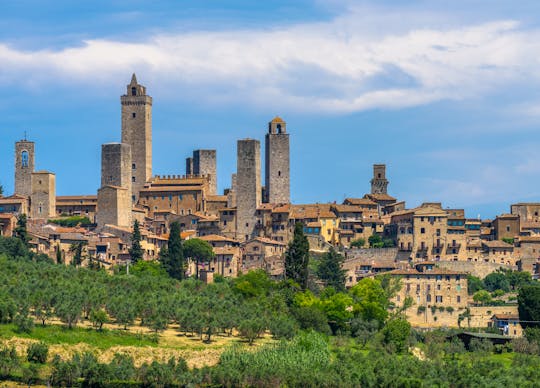Luxury holidays to Tuscany
Published 01 September 2019
Luxury holidays to Tuscany that explore its natural beauty and authentic appeal
Dotted with mediaeval hilltowns and cypress trees, vineyards and olive groves, Tuscany is an almost impossibly beautiful place, each cobbled, hilltop village more dreamily lovely than the last, each sunflower field and poppey-carpeted valley more recognisably like a Renaissance painting than the one before. Irresistibly appealing, it has called to sun-starved north Europeans, and Brits in particular, like nowhere else in Italy – not for nothing Shelley described it as a ‘paradise of exiles’. Tuscany’s towns may have grown since Shelley’s time, but great tracts of land still look much as they did half a millennium ago. Achingly lovely as it is, however, Tuscany’s appeal lies way beyond its mere beauty. Pivotal to the culture not just of Italy, but to that of the whole of Europe, Tuscany is riddled with masterpieces of painting, sculpture and architecture. From the humblest hilltop church housing priceless Sodoma frescoes to the grand cathedrals of Florence and Lucca, Siena and Pisa, the region is a veritable treasure trove of Giottos and Pisanos, Boticellis and Michaelangelos. And if Tuscany’s architecture doesn’t woo you, its food definitely will. Even though the percentage of people still making their living from the land has plummeted since the WWII, Tuscany is still essentially rural at heart, and even the humblest trattoria is bursting with the freshest of tomatoes and rocket, lamb and bread. Here, simple, rustic, exquisite country food is king, from bruschetta rubbed with garlic, olive oil and salt to magnificent ribollita (bean, cabbage and bread soup), and from outrageous cantucci dipped in Vin Santo to subtle pecorino made from sheep’s milk. Washed down with local Chianti and Brunello di Montalcino, served often on modest paper table cloths with the minimum of fuss, this, quite simply, is what Tuscany is all about. It’s la dolce vita country style. Come in autumn, and the landscape here is the gift that just keeps on giving, with seemingly every village and town staging its own harvest festival or celebration of the grape, and spectacular porcini suddenly appearing on every plate. Even the humblest fruit and veg shop suddenly groans with truffles. On the same latitude as the South of France, Tuscany’s long, Indian summers also make autumn a great time to come. Of course, with food this good – and this intrinsic to the landscape – it’s almost impossible not to want to cook. Inevitably, cookery courses have started popping up across the Tuscan map like tartufi in an ancient hazel forest. One of the very best is housed in Relais Il Falconiere, a stunning 17th palazzo hotel we feature just outside Cortona, with Michelin-starred restaurant, its very own vineyard, a spa specialising in natural products based on olives and grapes, and achingly lovely villas, each with their own pool. Standing in utter tranquillity surrounded by a garden of cypresses and horse-chestnut groves facing the rolling hills of eastern Tuscany, Il Falconiere still retains many of its original features, including a tiny chapel with delicate frescoes, as well as antiques dotted throughout the hotel. Bookended by the Alpi Apuane mountains to the north (whose quarries supplied the marble for Michaelangelo’s David) and the sun-baked clay hills of the crete to the south, Tuscany packs an astonishing variety of landscapes into a relatively tiny area, making it perfect for a twin-centre escape, with pretty coastal resorts offering the ultimate antidote once you simply can’t take another 16th century bell tower or Renaissance masterpiece. Gateway to the Alpi Apuane, Lucca – a quite stunning walled town fair littered with palazzi and Romanesque gems – is also a wonderful base for any couple that loves the outdoors, but doesn’t want to miss out on Tuscany’s cultural attractions. As you’d expect from a region so rich in history, Tuscany is also home to some fabulously colourful festivals. From the humblest watermelon festival in Asciano to the baroque grandeur of Siena’s notorious Palio, from Viareggio’s Mardi Gras carnival to Florence’s Calcio Storico, a frankly terrifying, bare-knuckle football match held every June in Piazza Santa Croce, the region is party-mad. And they’re not just laid on for tourists either. They’re fundamental to Tuscan life. Italians celebrate community like nowhere else in Europe - just witness the daily passeggiata, when Italians promenade around their towns just for the simple pleasure of chatting and strolling in the evening air – and Tuscany’s festivals simply reflect that. They are a wonderful addition to an already groaning menu of reasons to holiday here. For us, there is just no better holiday on the planet than pootling about between hilltop villages and towns, gorging on the scenery, soaking up the sun, punctuating a daily diet of duomos and campaniles with fabulous lunches in simple trattoria. Uniformly breathtaking, Tuscany is a place where you can virtually abandon your guide book: wherever your wanderings take you, it’s going to have a mediaeval square and outdoor trattoria just waiting to blow you away.
Hotel Borgo San Felice
Occupying an ancient hamlet, set amidst the Chianti vineyards, and with views of the towers of the city of Siena on the horizon, the Borgo San Felice offers a comfortable haven in which to relax, explore the nearby countryside and to delight in the gourmet delicacies of the region, with its superb restaurant, serving local specialities and its Enotecca where you can taste the estate-produced wines. Prices from about £1420 per person for 7 nights on bed and breakfast with British Airways flights to Pisa in Euro Traveller and hire-car.

